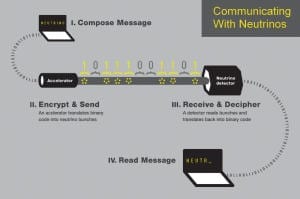It would be possible to communicate between any two points on Earth without using satellites or cables
A group of scientists led by researchers from the University of Rochester and North Carolina State University have for the first time sent a message using a beam of neutrinos — nearly massless particles that travel at almost the speed of light. The message was sent through 240 meters of stone and said simply, “Neutrino.”
“Using neutrinos, it would be possible to communicate between any two points on Earth without using satellites or cables,” said Dan Stancil, professor of electrical and computer engineering at NC State and lead author of a paper describing the research. “Neutrino communication systems would be much more complicated than today’s systems, but may have important strategic uses.”
Many have theorized about the possible uses of neutrinos in communication because of one particularly valuable property: they can penetrate almost anything they encounter. If this technology could be applied to submarines, for instance, then they could conceivably communicate over long distances through water, which is difficult, if not impossible, with present technology. And if we wanted to communicate with something in outer space that was on the far side of a moon or a planet, our message could travel straight through without impediment.
“Of course, our current technology takes massive amounts of high-tech equipment to communicate a message using neutrinos, so this isn’t practical now,” said Kevin McFarland, a University of Rochester physics professor who was involved in the experiment. “But the first step toward someday using neutrinos for communication in a practical application is a demonstration using today’s technology.”
The team of scientists that demonstrated that it was possible performed their test at the Fermi National Accelerator Lab (or Fermilab, for short), outside of Chicago. The group has submitted its findings to the journal Modern Physics Letters A.
At Fermilab the researchers had access to two crucial components. The first is one of the world’s most powerful particle accelerators, which creates high-intensity beams of neutrinos by accelerating protons around a 2.5-mile-circumference track and then colliding them with a carbon target. The second is a multi-ton detector called MINERvA, located in a cavern 100 meters underground.
The fact that such a substantial setup is necessary to communicate using neutrinos means that much work will need to be done before the technology can be incorporated into a readily usable form.
Read more . . .
Bookmark this page for “neutrino” and check back regularly as these articles update on a very frequent basis. The view is set to “news”. Try clicking on “video” and “2” for more articles.









